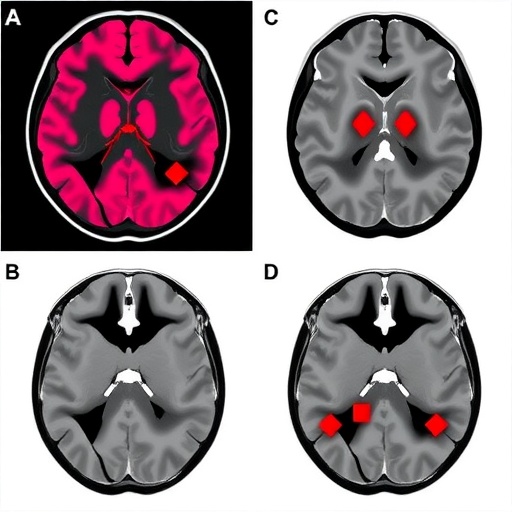In a groundbreaking study published in BMC Neuroscience, researchers have uncovered critical insights into the role of eosinophils, a type of white blood cell, in the context of stroke recovery following mechanical thrombectomy. The study, conducted by an innovative team led by S. Yu, J. Yang, and X. Han, explores how these immune cells can significantly affect both early and delayed neurological deterioration in stroke patients. This research not only enhances our understanding of the inflammatory processes post-stroke but also opens new avenues for therapeutic interventions aimed at improving outcomes for patients undergoing mechanical thrombectomy.
The research focuses on the complex interplay between eosinophils and neurological outcomes following ischemic stroke, a condition that can lead to significant morbidity and mortality. Mechanical thrombectomy, a common procedure employed to restore blood flow to the brain in acute ischemic stroke, is not without its risks and complications. The study posits that the presence and activity of eosinophils may play a dual role in either mitigating or exacerbating neurological damage in the critical hours and days following the procedure.
Previous studies have documented the inflammatory response that occurs after a stroke; however, the specific contributions of eosinophils have remained largely unexplored. The authors of the current study utilized a combination of animal models and clinical data to delve into the role of these cells in the post-thrombectomy environment. By analyzing the inflammatory markers and neurological outcomes of stroke patients, the researchers were able to identify a correlation between eosinophil activity and patient recovery trajectories.
In their study, Yu and colleagues highlighted that eosinophils could potentially exacerbate early neurological deterioration due to their pro-inflammatory cytokine production. This inflammatory response can lead to secondary injury following the initial ischemic event, thereby complicating recovery efforts. Interestingly, the research also suggested that eosinophils may confer protective effects in the later stages of recovery, helping to modulate inflammation and promote tissue repair.
One of the most compelling aspects of this research lies in its use of both human and animal data. By examining eosinophil counts and activity in stroke patients who underwent mechanical thrombectomy, the researchers were able to make significant correlations between eosinophil presence and functional outcomes. Furthermore, utilizing murine models allowed for controlled experimentation that provided deeper insights into the cellular mechanisms at play. This dual approach strengthens the validity of their findings and emphasizes the importance of translational research in stroke recovery.
The implications of these findings extend far beyond the immediate study. Understanding the dual roles of eosinophils could pave the way for novel therapeutic strategies that aim to modulate the immune response in stroke patients. For instance, if eosinophil activity can be therapeutically targeted, it may be possible to reduce the incidence of early neurological deterioration while promoting recovery in the subsequent phases. Such approaches might involve eosinophil depletion strategies or modulation of their cytokine releases, thereby creating a more favorable healing environment after a stroke.
Moreover, the increasing appreciation of the immune system’s role in neurological processes has also garnered attention in recent years, with researchers recognizing the intricate relationship between immune cells and neuronal health. This study significantly clings to the growing body of literature that aims to reassess the historic viewpoints of immune cells as mere responders to injury. Instead, it places eosinophils in a more dynamic role, challenging existing paradigms and encouraging further investigations into their multifaceted functions in the central nervous system.
The study also prompted a re-evaluation of current post-stroke care protocols, emphasizing the need for a more personalized approach to managing patients after mechanical thrombectomy. For example, monitoring eosinophil levels in the days following surgery could provide valuable prognostic information that informs treatment decisions. Enhanced understanding of individual inflammatory responses could allow clinicians to tailor interventions that either enhance positive outcomes or address potential complications early in the recovery phase.
This investigation undoubtedly opens up new research avenues, inviting exploration into various aspects of stroke pathology and recovery. The dynamic roles of various immune cells and their interplay in the context of ischemic injury and recovery warrant comprehensive studies that can further delineate how such interactions influence patient outcomes. By linking immune responses with cellular health, researchers can better design therapeutic interventions that address not just the immediate effects of stroke but also the longer-term recovery trajectory.
In summary, the study by Yu and colleagues presents a significant advance in our understanding of stroke recovery, shining a light on the complex roles eosinophils play in mediating outcomes after mechanical thrombectomy. Their findings encourage a shift towards understanding the immune system in a more nuanced manner, lending credence to the idea that harnessing the beneficial aspects of immune responses could lead to better clinical outcomes for stroke patients. As the field of neuroscience continues to grow and evolve, studies like this serve as essential building blocks that progress our understanding and treatment of one of the leading causes of disability worldwide.
The connections between immune cell dynamics and neurological function are intricate and complex. As we further investigate the immune-neural interface, the identification of unique cellular trajectories will provide critical insights that could revolutionize stroke management. With the findings of this study, we take a concerted step forward, laying down the groundwork for future research aimed at improving therapeutic interventions for patients recovering from strokes.
With the evolving landscape of neuroscience research, it is vital that we remain attuned to the interplay of various biological systems. The work on eosinophils and their roles in neuroinflammation and recovery post-stroke is a prime example of how integrating knowledge from different fields can yield comprehensive insights. The scientific community now stands poised to leverage this research in the pursuit of innovative treatment strategies that promise to improve outcomes for millions affected by stroke.
With rigorous investigations that scrutinize the role of immune cells like eosinophils, the narrative surrounding stroke recovery is shifting. Awareness of such contributions can catalyze the creation of novel approaches aimed at not only treating the immediate aftermath of stroke but also fostering an environment conducive to recovery and neuroprotection. The future indeed holds promise, guided by studies that illuminate the path ahead for improving care for stroke victims everywhere.
Ultimately, the advancements highlighted in this study are a testament to the importance of continued research in the field of neuroscience. By understanding the nuances of cell-mediated immunity and its impact on neurological recovery, researchers and clinicians can aspire towards an era where stroke management is not merely reactive but proactive, targeting underlying biological mechanisms to foster better rehabilitation outcomes.
Subject of Research: The role of eosinophils in neurological outcomes following mechanical thrombectomy in stroke patients.
Article Title: Eosinophils differentially affect early and delayed neurological deterioration after mechanical thrombectomy in stroke.
Article References:
Yu, S., Yang, J., Han, X. et al. Eosinophils differentially affect early and delayed neurological deterioration after mechanical thrombectomy in stroke.
BMC Neurosci 26, 34 (2025). https://doi.org/10.1186/s12868-025-00954-8
Image Credits: AI Generated
DOI:
Keywords: Eosinophils, stroke, mechanical thrombectomy, neurological outcomes, inflammation, immune response.
Tags: BMC Neuroscience publication on stroke recoverycomplications of mechanical thrombectomydelayed neurological deterioration in stroke patientsearly neurological deterioration after thrombectomyeosinophils and stroke recoveryeosinophils influence on brain healthinflammatory processes post-strokeischemic stroke and immune responsemechanical thrombectomy and neurological outcomesrole of white blood cells in stroke recoveryS. Yu J. Yang X. Han research studytherapeutic interventions for stroke improvement





